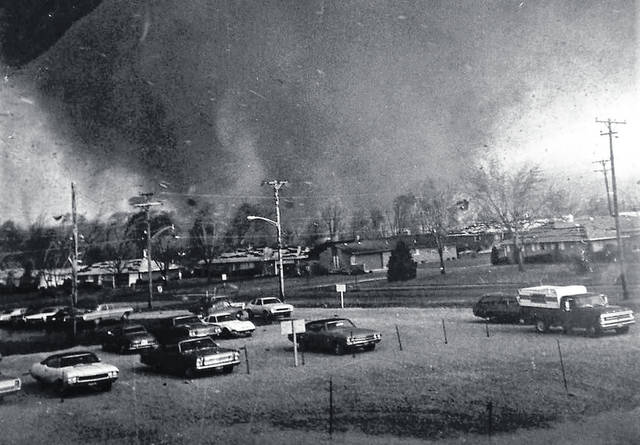
All it took was four minutes 45 years ago Wednesday to change the landscape and the lives of the residents of Xenia when a killer tornado roared through its Arrowhead subdivision and downtown area, eventually killing 33 people and injuring another 1,300 in its more than one-mile wide path.
David Bushelman, director of the Highland County Emergency Management Agency, told The Times-Gazette that he really doesn’t have any clear memories of that day since he was only 9 years old at the time, but did say Highland County is better prepared to deal with an F-5 Xenia-class tornado today than it would’ve been the afternoon of April 3, 1974.
“Our communications systems are better, our infrastructure, as far as handling major disasters like that in the state as a whole, are geared to rapid response,” Bushelman said. “Combine that with the upgrades and improvements with the weather service and I’d say from an emergency management standpoint, we’re more than ready for a tornado of that sort.”
Major weather events such as the Great Flood of 1937, the Thanksgiving Blizzard of 1950, the freezing of the Ohio River in 1977 and the legendary blizzard of 1978 leave an indelible mark on those that went through them, and according to the National Weather Service, the tornado that devastated Xenia was no different.
A series of violent tornadoes now referred to as the “Super Outbreak,” tore a path of death and destruction through Ohio, Indiana and Kentucky, and the National Weather Service said it documented 148 tornadoes in 13 states in the eastern United States that day alone. But the most deadly was the F-5 funnel cloud that descended suddenly upon Greene County.
“When severe weather like that starts creeping in, my office goes into the assessment and monitoring stage,” Bushelman said. “We start making preparations to make sure everything is up and running, and stay in close contact with other county EMA directors and the National Weather Service.”
He said his office’s main objective during a crisis situation, be it storm-related, man-made or natural disaster, is to prepare, respond, recover and mitigate. In other words, anticipate what could happen, respond accordingly, and then coordinate aid and assistance in the aftermath.
Kristen Cassady, a meteorologist at the National Weather Service office in Wilmington, said that even today in the weather community, the April 1974 super outbreak is looked upon with awe, and is often compared with a similar outbreak that occurred in the Deep South on April 27, 2011.
“Those violent tornados that day thankfully didn’t quite reach up here,” she said. “That’s the only other day that rivals the April 1974 outbreak. In fact, there were tornado watches that day in 2011 that stretched from upstate New York all the way down to the Gulf Coast.”
She said one of the things that enables the weather service to better forecast severe weather is the advances in radar technology, which is superior to what existed in 1974, such as next generation Doppler radio deployed at major airports that allows detection of low altitude storm activity. She said it can show the presence of a tornado before it even touches the ground.
“What was in use back then we referred to as WSR-57 radar, which meant ‘weather service radar’ and the year it came out, which was 1957. Later on we had the WSR-74s,” Cassady said. “That was replaced with the WSR-88D, which included Doppler radar and the subsequent upgrades to give us the forecasting capabilities we enjoy today.”
She said communities are more safe today than they were 45 years ago not only due to advances in technology like Doppler radar and computer generated imaging, but also because meteorologists have a better understanding of how weather systems evolve.
“When the storm prediction center issues a thunderstorm outlook across the entire country, today we not only have several hours warning, but also several days that the environment could spawn these tornadic outbreaks,” she said. “Being able to provide that heightened awareness is crucial so now people aren’t just planning for the day of, but can now make plans several days before.”
The faces and the names of the victims of the Xenia tornado have faded from memory over time, but statistics tell their story, according to “Tornado at Xenia,” a tribute publication from 1974 that was sold to benefit recovery efforts.
Of the deaths in Xenia, 12 were children under the age of 16, with the youngest victim being a 4-week-old boy, the oldest an 82-year-old woman, and two were airmen from the Ohio Air National Guard.
In the four short minutes the twister was on the ground in Xenia, the publication noted, 18 of the victims were found in or near piles of rubble where their homes once stood, nine died at their places of employment and five others were killed while enjoying a late afternoon meal at a local restaurant.
Reach Tim Colliver at 937-402-2571


